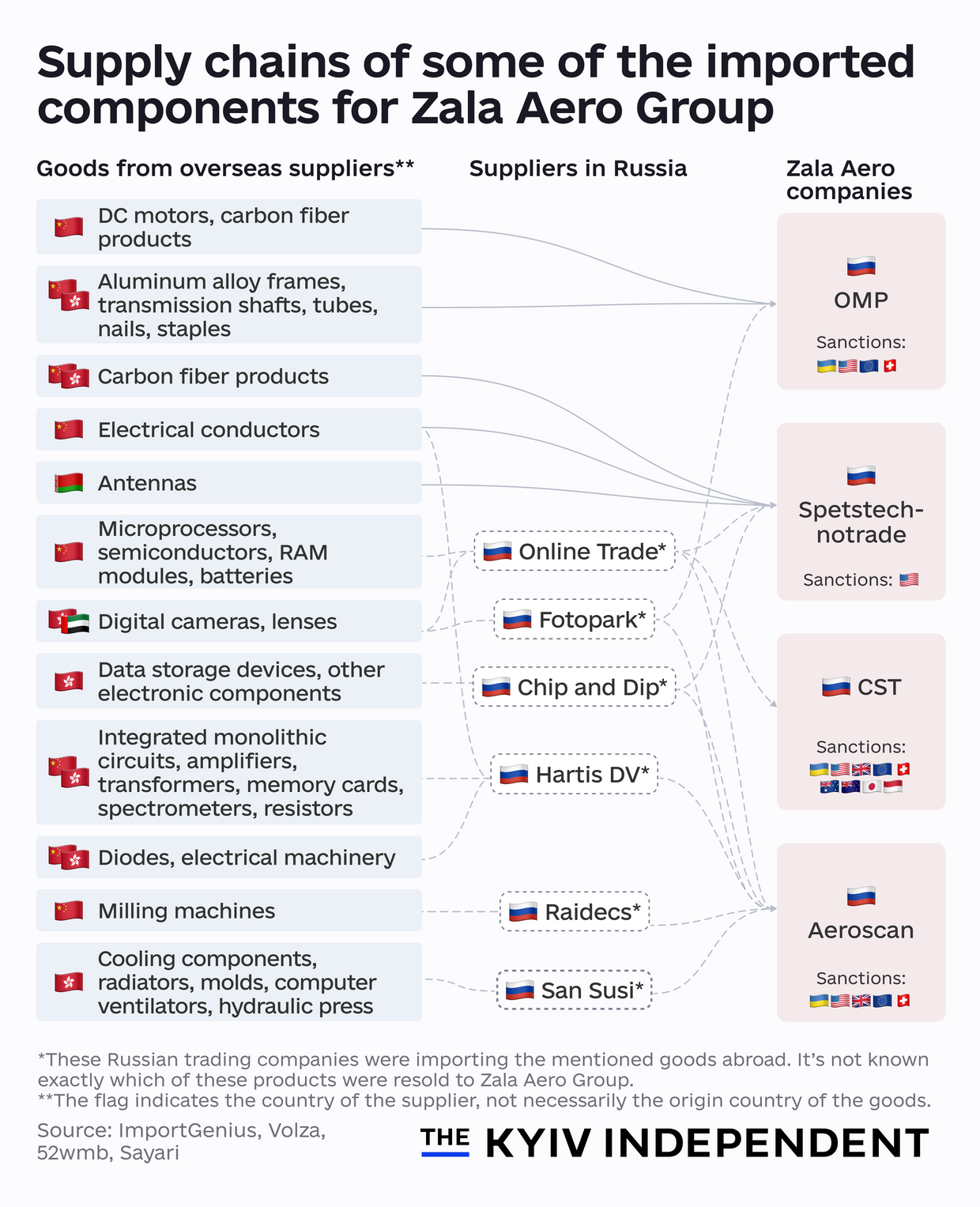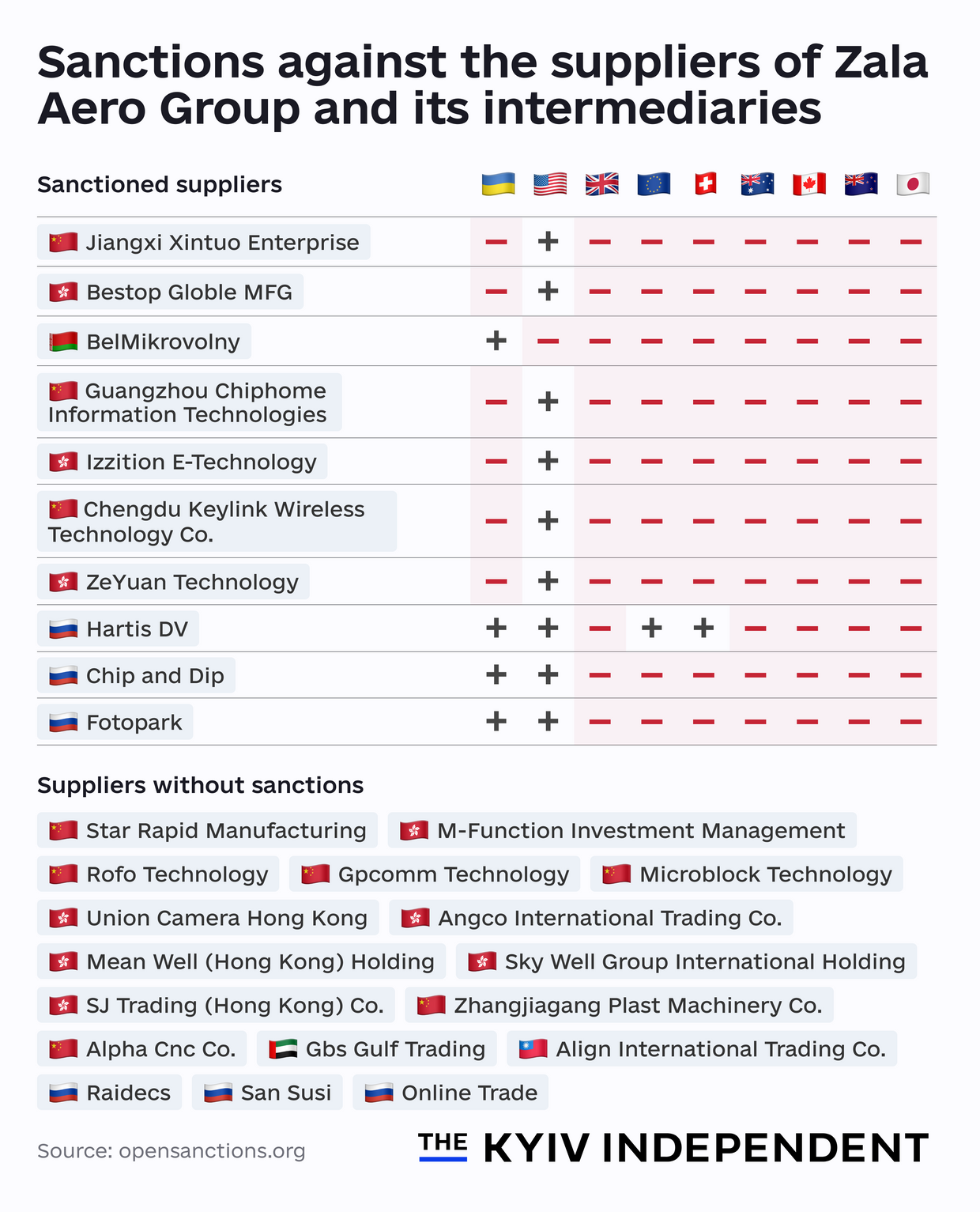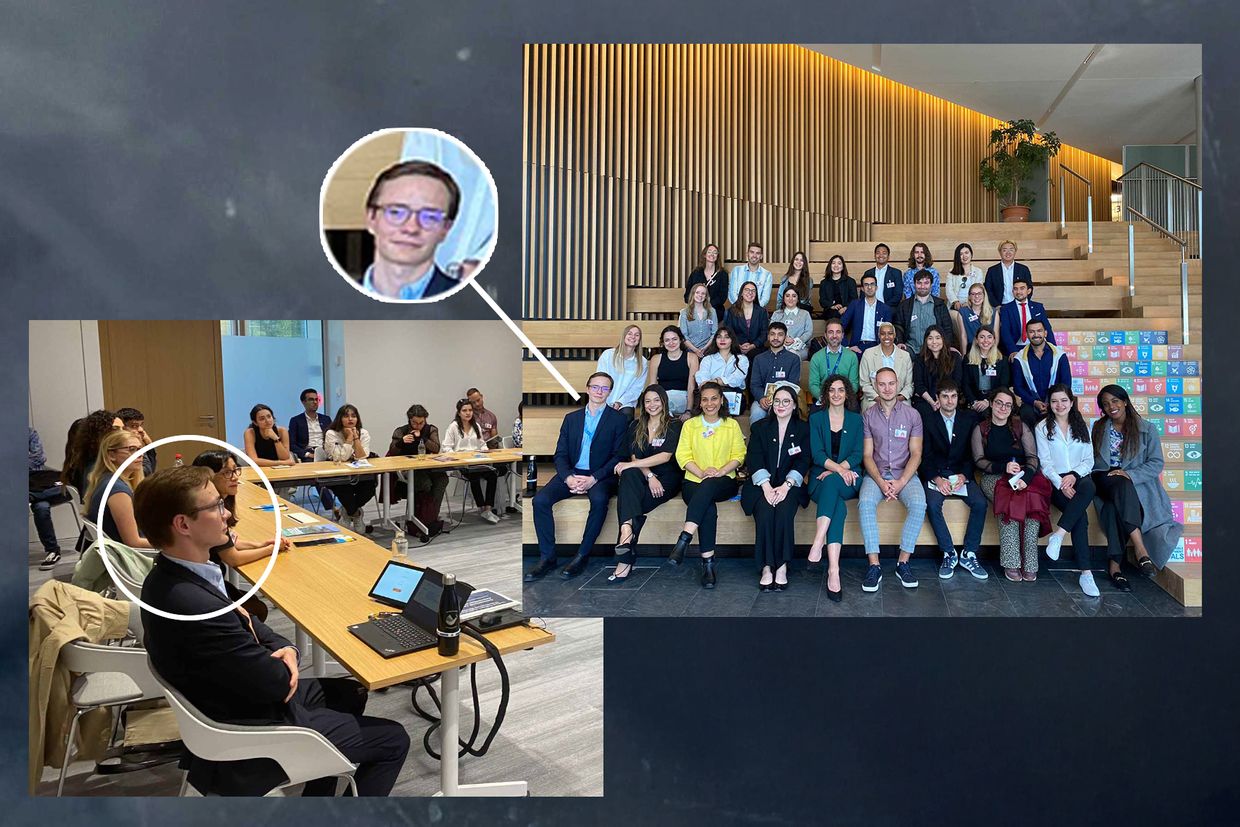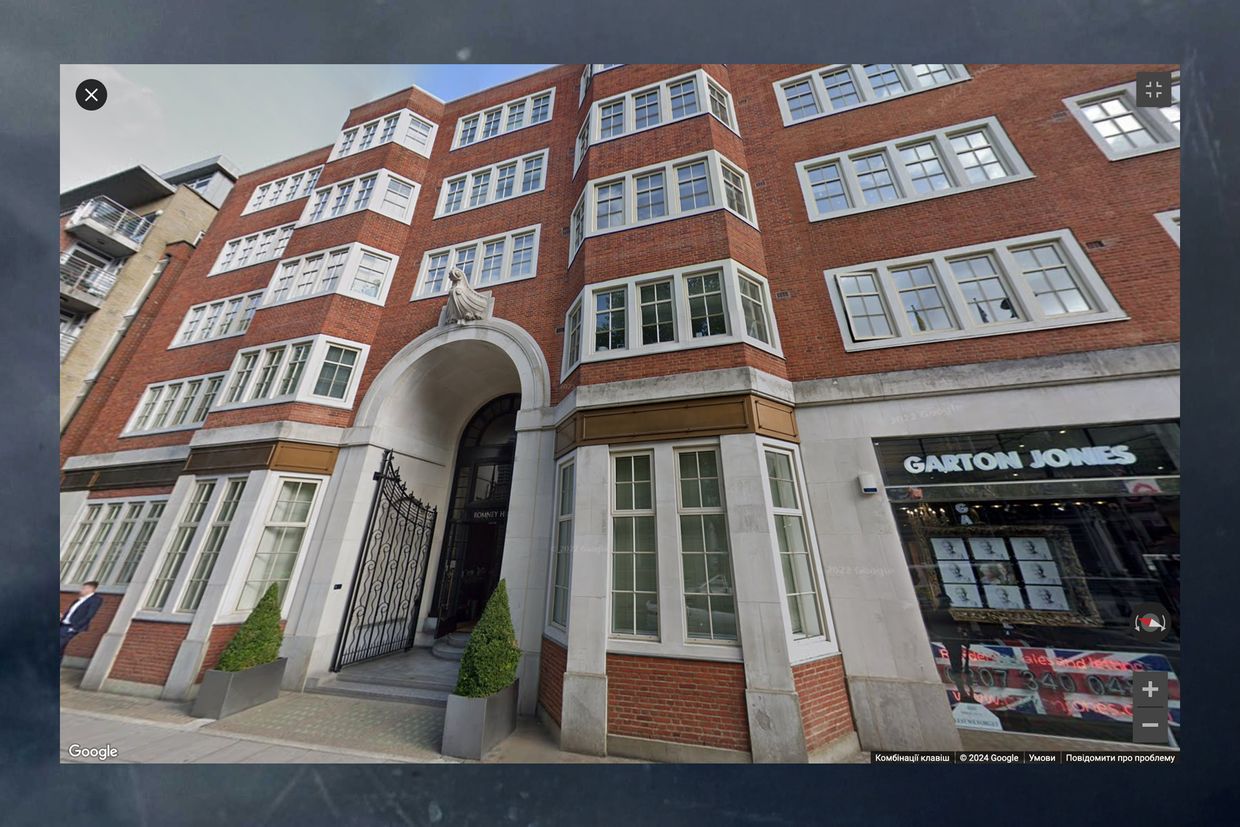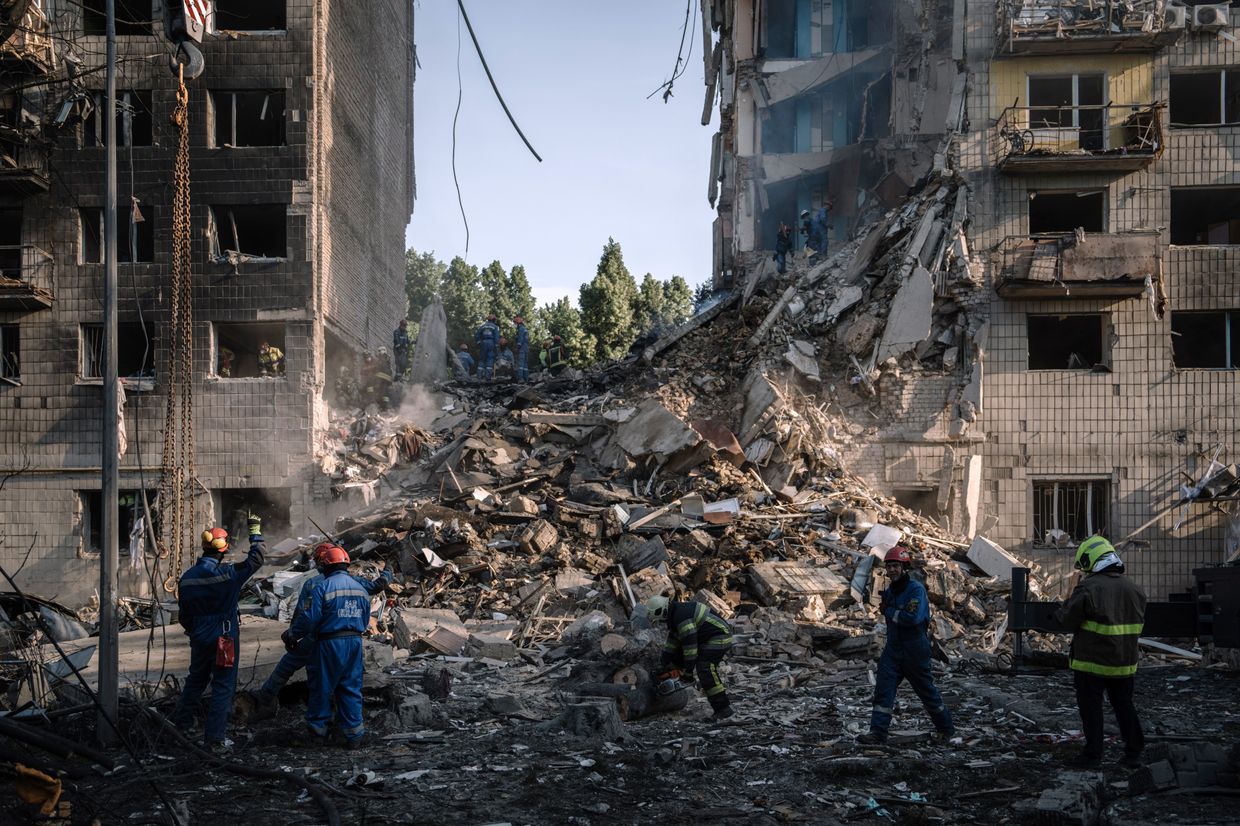An American-made HIMARS artillery system races down a Ukrainian road as a kamikaze drone hunts it down. The drone flies into the vehicle, followed by an explosion. The scene was caught on video by a Russian reconnaissance drone in mid-November.
The drone that hit the HIMARS was a Lancet — one of Russia’s most used unmanned aerial vehicles (UAV). Russia has used thousands of them against Ukraine.
The weapons are produced by Zala Aero Group, a privately-owned group of Russian companies, with the state holding a minority stake in one of its entities. It is one of the largest manufacturers of Russian combat drones attacking Ukraine.
Like other Russian defense producers, the group has been targeted by Western sanctions and export restrictions that seek to undercut the Russian war effort by prohibiting the sale of defense-related parts and tech to Russia.
In theory, the sanctions are supposed to be effective against the production of drones, which are highly dependent on imported parts.
In reality, the use of Zala Aero’s drones in the Russian war against Ukraine has been growing. Over the past year, it tripled.
An investigation by the Kyiv Independent has found that Zala Aero has managed to continue to grow, despite sanctions, by feeding its production through a reliable system of Chinese suppliers.
The investigation started when the Kyiv Independent obtained emails of Zala Aero Group employees that were hacked by Ukrainian intelligence.
The emails illustrate how much Zala Aero's drone production depends on imported components.
The Kyiv Independent tracked down Russian tax data on the suppliers of the Zala Aero Group and Russian customs records on the imported goods it was purchasing. This revealed the ecosystem of suppliers — foreign and domestic — that feed Zala Aero’s drone production.
Having read through thousands of lines of Zala Group business transactions and hundreds of work papers, the Kyiv Independent can now show how China came to the aid of this part of the Russian military machine, likely supplying it with more than just Chinese components.
We also looked into what can be done to close the loopholes and stop Russia's deadly drone production, which is still dependent on imports.
Zala, a private company behind Russia’s close-range drones
The most well-known military products of the Russian Zala Group are the Lancet attack drones and Zala reconnaissance UAVs. The Lancet kamikaze drones attack Ukrainian infantry and military vehicles, while the reconnaissance drones work alongside them, serving as the eyes of the Russian army to help identify targets.

Lancet kamikaze drones can’t fly as far as Iranian Shaheds and their Russian-made versions, the Geran, which attack Ukrainian cities far from the battlefield every night. Instead, Lancet drones are used on the battlefield, targeting the Ukrainian military along the entire front line.
Lancets can carry 3-5 kilograms of explosives and fly 20-40 miles — enough to damage, and sometimes destroy, large military vehicles, including tanks, artillery systems, and planes on the ground. Russia first used them in Syria. Since mid-2022, Lancets have been a mainstay of the Russian drone arsenal in Ukraine.
Zala doesn’t just supply the Russian war — it appears to fully align itself with it.
Zala Aero Group publicly brags about fresh Lancet attacks on equipment provided to Ukraine by its partners. The group claims Lancets have hit German Leopard and American Abrams tanks, American Paladin, British M777, and French Caesar howitzers, as well as Ukrainian-made vehicles.
“Targets are being hit round-the-clock,” one of the company’s social media posts boasted of the use of Lancets in October 2024. “The work is carried out along the entire front line and in the rear.”
Among the hacked emails obtained by the Kyiv Independent, there is a letter by a Russian army commander, dated April 2023. In the letter, he addresses the CEO of Zala Aero, commending the company’s instructors who help in training the Russian military to operate their drones.
“I look forward to further cooperation,” the letter concludes, “and increasing the production and supply of unmanned aerial vehicles and loitering munitions.”
That’s exactly what happened next — Zala began producing more drones.
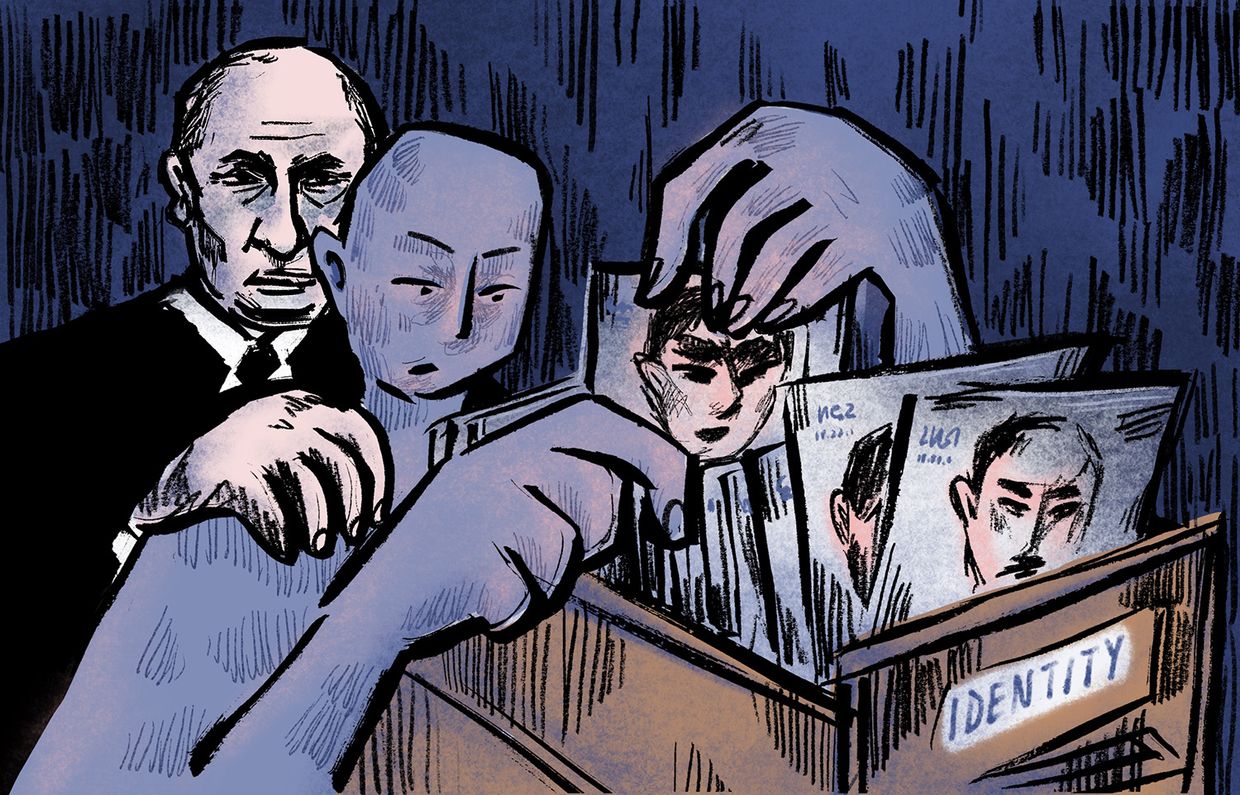
Lancets on the rise
Russia has used around 7,000 Lancet drones against Ukraine as of early November 2024, the Ukrainian Air Force told the Kyiv Independent. “There is a steady increase in the use of these munitions,” they added.
A Russian site monitoring military equipment losses, Lostarmour, lists over 2,500 Lancet drone attacks against Ukraine, confirmed by video evidence.
Even this limited data is enough to spot a clear trend: The confirmed use of Lancet drones in Russia's war against Ukraine in the first 10 months of 2024 increased almost threefold compared to the same period in 2023: 1,654 cases versus 629, according to Lostarmour.
“Up to eight Lancets can fly over us per day, and they always work in tandem with Zala drones that guide attack drones,” a Ukrainian soldier currently participating in the operation in Russia’s Kursk Region told the Kyiv Independent. The soldier is not publicly identified due to security restrictions.
Besides the effect on the battlefield, there is another indicator that Zala is growing its output: The group has been investing in production. Since mid-2022, they started building new production facilities and buying equipment, according to Agiya Zagrebelska, a Ukrainian expert on sanctions policy who has been closely watching Zala.
The internal documents obtained by the Kyiv Independent also show that, after the start of the full-scale war, the company has bought new equipment. In September 2022, one of the Zala Aero Group's key companies, Aeroscan, ordered seven milling machines for a total of nearly $800,000. These machines, manufactured by the Chinese company YangSen, are used in drone production.
There wouldn’t be anything odd about a military manufacturer growing in the time of war — except that this manufacturer can’t work without imported parts, which international sanctions have cut off — in theory.
Import dependence
Like all kamikaze drones, Lancets self-destruct when they attack, making it difficult to analyze their hardware. One thing is certain: A lot of their parts aren’t of Russian origin.
The internal correspondence contains an audio recording of a meeting between representatives of the Russian government and drone manufacturers that offers a glimpse into just how concerned they were with the industry’s dependence on imports.
The meeting most likely took place in Moscow in February 2023. At one point, Dmitry Peskov, Vladimir Putin’s special representative for technological development, and a namesake of the Russian president’s notorious spokesman, appears to pop up into the room — the meeting’s chairman notes his brief appearance, but Peskov isn’t heard talking.
The meeting focused on the upcoming Unmanned Aircraft Systems project — a Russian state program that aims to support and grow the Russian drone industry from 2024 to 2030. The project has since been approved and launched.
Almost every person speaking at the meeting raised the problem of drone manufacturers' dependence on imported electronic components and engines.
“I'm very much concerned about components, I'm very much concerned about onboard electronic equipment,” the meeting’s chairman, whom we identified as Vasilii Shpak, deputy industry and trade minister of Russia, said at the beginning of the meeting, setting the tone.
During the conversation, Shpak noted he had a wealth of experience in delivering components from anywhere in the world to meet the needs of Russia’s war against Ukraine.
“The more serious difficulties we face are the lack of domestic motors for our heavy machines that we want to launch… and the fact that some of the components we want to replace are not always available in Russia,” said Nickolay Burdin, commercial director of the Russian private company Aeromax.
“We can’t do without imports for now,” the chairman summarized.
Another document the Kyiv Independent found in the correspondence also illustrates Zala Group's dependence on imports. The document is a 2019 Microsoft Word file titled “List of electronic components.” It apparently refers to the electronic components that Zala Aero Group was using or was going to use in the production of its drones back then. The document lists 24 components manufactured by Keysight Technologies, a U.S. company.
Five years later, the Lancet drones still use foreign parts of mixed origin.
Ukraine’s military intelligence agency, known in Ukraine as HUR, maintains a public register of foreign components discovered in captured Russian weapons and military equipment. It includes a list of components found in three Lancet models that were downed in Ukraine. Among them, there are no components from Keysight Technologies. But there are products from many others.
The Lancets had components from a number of American companies: Nvidia, National Semiconductor, Microchip Technology, Micron Technology, Xilinx, Texas Instruments, Atmel Corporation, Analog Devices, Qorvo, Maxim Integrated Products, Bel Fuse, and Semtech Corporation.
There were also components from other countries: Swiss companies STMicroelectronics, U-blox, and TE Connectivity; the German company Infineon Technologies; Dutch companies NXP Semiconductors and Skoopia; and South Korea’s Ricci Microwave and SK Hynix, and others.
Some of the components remained unidentified, their origin unknown.
Among the imported components required by Zala Aero, one will find chips, microprocessors, cameras, video encoders and decoders, microcontrollers, transceivers, resistors, transistors, and batteries.

So the question is: How did Zala Aero Group, so dependent on imported components, manage to increase drone production despite the sanctions and export restrictions that were meant to stop the flow of microelectronics and machine tools into Russia?
Tracing foreign components’ path to Russian drones
Following the start of Russia’s full-scale war, a number of countries imposed export controls, prohibiting the sale of microelectronics, motors, and machine tools to Russia.
Instead of getting the necessary supplies from America or Europe, Russian producers now buy them from third countries.
Russia’s biggest helper here is China. This country makes up for Russia's deficit both with its own production and as a distributor of foreign manufacturers.
China has become the lifeline of the Zala Aero Group.
We have studied the import data of several Zala Aero Group companies in 2022-2024, received with the help of OCCRP, an international investigative journalism group. We identified the two companies that imported foreign parts for Zala Aero’s drone production — OMP and Spetstechnotrade.
The two companies have different owners than the rest of the group. One was founded by a Zala Aero employee and another — by an employee’s father. The ownership structure appears to be an attempt to safeguard the companies from a direct association with military production, which could have complicated foreign trade for them.
These two companies are suppliers to Zala Aero’s two main drone manufacturers — Aeroscan and CST, according to Russian Tax Service data.
The import records indicate they have purchased goods from a number of Chinese and Hong Kong suppliers: Jiangxi Xintuo Enterprise, Bestop Globle MFG, Star Rapid Manufacturing, Microblock technology, Gpcomm technology, and M-Function investment management.
Chinese and Hong Kong partners supplied Zala Aero’s companies with motors, electrical conductors, carbon fiber products, aluminum alloy frames, and aluminum products worth millions of dollars. These components are used in drone production.
Some of these Chinese and Hong Kong entities are listed in customs databases not only as sellers but also as manufacturers of the sold products, including motors.
The Kyiv Independent sent out inquiries to several Chinese and Hong Kong companies selling components to Zala Aero Group, asking about the products they sell ending up in Russian drone production during the war. Other companies from the list of suppliers have no public representation or contact details.
One of the suppliers, Star Rapid Manufacturing, responded. According to their reply, the Russian company OMP misinformed the company, claiming its business activities were not related to military production.
“At the time of our dealings, OMP presented itself as an independent entity, and OMP confirmed that the parts were not related to military equipment,” wrote the company. “Upon becoming aware of OMP’s association with Zala Aero Group, which we were previously not aware of, and their inclusion in sanctions, we promptly ended our business relationship with OMP.”

But the two affiliated companies, OMP and Spetstechnotrade, don’t cover all of Zala Aero’s needs for imported components. Zala Aero also uses other, unaffiliated external Russian suppliers.
These Russian intermediaries import and resell components, both Western and Asian-made.
One of them is a Moscow-based supplier named Online Trade. In 2024, this company repeatedly sold goods to several entities of Zala Aero Group: CST, Aeroscan, and Spetstechnotrade. Evidence of these deals is found in the leaked data of the Russian Tax Office.
The data doesn’t specify which items Online Trade supplies to Zala Aero, but the import database shows that Online Trade has been bringing large volumes of video cameras and lenses, as well as microelectronics, to Russia.
The Russian company bought the cameras from a number of companies, including the Hong Kong-based companies Angco International Trading and Union Camera Hong Kong. They are distributors, not producers: They resell cameras, including Western-made ones.
Its chains like that — a Hong Kong reseller, a Russian broker, and finally a Russian drone manufacturer — that put a Western-made camera inside a drone that hunts down Western-donated equipment on the battlefield in Ukraine.
Online Trade is not the only Russian intermediary reselling imported components to Zala Aero Group. Other Russian companies also supplied it with items in 2024: Chip and Dip, Hartis DV, Raidecs, San Susi, Fotopark, and others.
Among the Hartis DV suppliers was a Hong Kong company Izzition E-Technology which calls itself a distributor of Western brands like NXP, Altera, and Xilinx. The NXP and Xilinx products were found in Russian Lancets downed in Ukraine.
For details about the import procurement of Zala Aero’s Russian suppliers, see the following chart:
The China problem
China has become a convenient back door for Russian companies in need of the goods that fall under export restrictions, imposed by a number of countries to deprive Russian military production of key components.
Before selling sensitive goods to China, companies from those countries have to check that they will not be heading to Russia. In reality, often, only the “first-tier” buyer ends up checked, and not the end consumer to whom goods will be resold.
In an effort to publicly distance itself from Russia’s, China promised to tighten restrictions on the supply of drones and components to Russia.
But experts are somewhat skeptical about the actual impact of these statements, given previous experience.
“China has proven itself unwilling to strictly enforce export restrictions on electronic goods, especially those produced by Western firms, from going to Russia,” Spencer Faragasso, a senior research fellow with the Institute for Science and International Security (U.S.), told the Kyiv Independent.
China has positioned itself as neutral in the ongoing war but has been supplying Russia with materials that directly boost its war machine, receiving military technology support from Russia in return, U.S. Deputy Secretary of State Kurt Campbell said recently.
“The sanctions coalition countries have three options for responding to China's role in supporting Russia's military machine,” says Agiya Zagrebelska, the Ukrainian sanctions expert.
“The first is to escalate economic restrictions with China. But let's be honest, no one is ready to take this step, because China is too big a market. The second option is to leave everything as it is. And the third is what we are proposing: the implementation of real penalties against component and machine tool manufacturers (in the form of) investigations and fines.”
Zagrebelska says that manufacturers pay attention only to the first buyer in the chain because no one punishes them for turning a blind eye to where the goods end up.
“We call it willful blindness. We are convinced that with all the modern capabilities of big data and artificial intelligence, a manufacturer is able to identify risky buyers by their typical characteristics,” says Zagrebelska.
A similar idea of fines for Western producers combined with government support to move their plants outside of China has also been proposed by the American Institute for Science and International Security.
“The unfortunate reality is that Western electronics companies, particularly those based in the U.S., have not done enough. They can legitimately be accused of helping to arm Russia in its bloody attacks on Ukraine,” the Institute writes in a recent report. “Western countries are supplying Ukraine with tens of billions of dollars worth of military equipment to defend Ukraine from Russian weapons that could not function without Western electronic goods. Halting the flow of these items can have a meaningful impact on Russia’s ability to field its weapons against Ukraine.”
The family behind the drones
The owners of Zala Aero Group, Aleksandr Zakharov and his family, are among the main beneficiaries of the Russian war’s insatiable hunger for drones.
In the first quarter of 2024 alone, Aeroscan, a company part of the Zala Aero Group, earned nearly $90 million by supplying the Russian Defense Ministry, military units, and the logistics center of Russia’s National Guard with products, according to Russian Tax Service leaked data.
The leaked emails of Zala Aero's employees allow us to map out the roles that members of the Zakharov family play in the business.
The elder Zakharov is the main owner and chief designer of Zala Aero.
His son Nikita Zakharov is the founder of several Zala Aero Group companies, mostly involved in software development. Recently, the Russian tax authorities closed public access to the data on the founders and managers of the companies created by Nikita Zakharov in the Russian company register. This is done for companies that perform state defense contracts or are under international sanctions.
The father and the son appear to be the brains behind Zala Aero Group. In the email leak available to us, there is a document called “Structure.” It contains a list of employees of the entire group as of February 2021. Some of the employees are marked as supervised by Aleksandr Zakharov, others are supervised by his son Nikita.
It marks employees as subordinated to AV, which it explains stands for Aleksandr Vladislavovich Zakharov, or NZ, for Nikita Zakharov.
Zakharov's wife Svetlana is in charge of the administrative side of the business, including renting production facilities. Their daughter Maria is the founder of several software development and research companies that until recently were part of the group, but that are now being dissolved.
Until recently, Zakharov's younger son Lavrentii was not publicly listed among the founders of any Russian companies.
He resided in Europe and attended a London university, occasionally visiting Russia. However, our documents show that he was involved in his Russian family’s business even while studying in London.
The leaked correspondence contains his reports on the flaws in the TiEn unmanned flight simulator, another development of the Zala Aero Group, which he apparently tested.
The reports date back to July 2019, when Lavrentii Zakharov was 20 years old. At the time, he was studying at University College London and was a member of the UCL Eurasian Business Society, an organization that unites the Russian-speaking community in London. At the same time, he managed to test a drone simulator developed by his family’s company.

Lavrentii’s European life was marred in the summer of 2023, when independent Russian investigative outlet iStories revealed that the son of the Russian drone tycoon had interned at the United Nations Institute for Disarmament Affairs in Geneva.
The story also found that the Zakharov family owned an apartment in central London worth 1.5 million pounds.
The investigation also revealed that none of the family members were under personal international sanctions at the time, despite their business’s role in Russia’s war effort.
After the story ran, the Zakharovs were sanctioned by the U.K. and the U.S., which means that their assets in these countries should be frozen. The UN Institute has removed the page that mentioned Lavrentii Zakharov's internship. He has the internship marked as completed in September 2023 on his LinkedIn page.
The EU and other Western and non-Western countries haven’t imposed personal sanctions on the Zakharovs yet.
Our investigation shows that after the scandal, the youngest Zakharov apparently returned to Russia.
In December 2023, Lavrentii Zakharov founded his own company in Moscow called Zakharov and Grek Technical Bureau, a technology consulting firm. And in 2024, we spotted him in a photo with Russian model Natalia Kozyreva, taken in Moscow, apparently on her birthday.
The sanctions seem to have brought the entire Zakharov family to Russia. This is where their effect has been exhausted, for now.
But this does not mean that the channels that feed the Russian military machine can’t be cut off.
Western suppliers could stop selling critical components to Chinese intermediaries that resell them to Russia.
Chinese companies could also adhere to their government's stated policy of not selling drones and components to the aggressor.
Together, these steps would deprive Russia of some of the key weapons it uses to wage its war in Ukraine.
Note from the author:
Hey! This is Alisa Yurchenko, I wrote this story. Thank you for reading this far, it was a long one to get through.
It’s upsetting that the Russian manufacturer at the center of the story can still produce weapons that attack Ukraine, even though Russia doesn’t make critical components for them domestically.
But I'm glad that I was able to demonstrate how the manufacturer imports the components from abroad. I hope this will draw attention to the problem, which is actually much broader than a single drone manufacturer.
This by no means signals that sanctions are useless. On the opposite: The story shows how dependent Russian manufacturers are on imported components, and how vulnerable they really are to trade limitations. It means that if sanctions and exports controls are improved, and enforced, they have real potential of severely undermining Russia’s war effort.
If you find this issue important, as I do, please support our work by becoming a member of the Kyiv Independent. Our readers’ support allows us to produce investigations like this.





